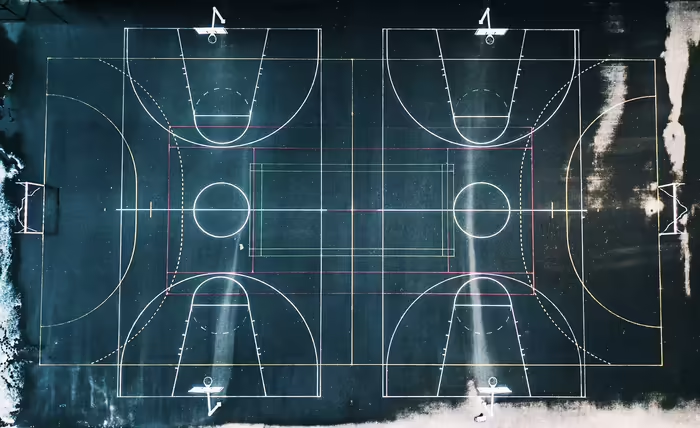
Geometric curves on a sports court by Barna Bartis on Unsplash
A few years ago, I restarted solving math puzzles and math contest problems—I mentioned this in passing in my post on the derivation of the quadratic formula. Well, among others, I’ve been working through some of the problems from the archives of the Virgnia Tech Regional Mathematics Contest (VTRMC), and I’ve created a new section on my website to host the problems from the contest and my solutions for them.
While the VTRMC archives includes problem sets going back to the beginning of the contest (1979), the solutions are only available for contests starting with 1987! So, naturally, I’m primarily working through the problems that don’t have publicly-posted solutions.1
But why solve these problems in the first place? Finding solutions to these problems wouldn’t lead us to any new discoveries, as they are known to have solutions (even if not published). For one, I enjoy puzzles and solving math contest problems in that regard is fun. Another reason is that they’re good practice for learning to solve other types of problems, including open problems, because it’s not necessarily obvious how to approach a problem (as no hints are given), and finally, discovering the solution to a problem and having that “ah hah!” moment is a great feeling.
A sample problem
Those of you who may be reading this blog because of my earlier posts on software and computing topics such as containers, REPLs, shell customizations, etc., might wonder how it would be relevant to you and how you might see the fun or interest in solving abstract math problems that have no relation to your interests or reality.
If this is you (or even if that’s not your thing!), I invite you to consider the following interesting problem:
Let $A = \lbrace a_0, a_1, … \rbrace$ be a sequence of real numbers and define the sequence $A' = {a_0', a_1', …}$ as follows for $n = 0, 1, …$: $a_{2n}' = a_n$, $a_{2n + 1}' = a_n + 1$. If $a_0 = 1$ and $A' = A$, find
- $a_1, a_2, a_3$ and $a_4$
- $a_{1981}$
- A simple general algorithm for evaluating $a_n$, for $n = 0, 1, …$
If you’d like to see my solution to this problem, see this page, but the fun part is solving it, so try solving it before looking at the solution! I have a few hints on that page if you need them.
Once you solve it, hopefully, you’ll see why I specifically recommend this problem as a starting point for folks with an interest in computing and software development. And for everyone else: I hope you’ll see that it’s a fun problem nonetheless.
$$ \ast \ast \ast $$
Attempting to solve these problems is very humbling, as they are difficult, and the process also shows you the gaps in your knowledge, and gives you pointers on what you’re missing that you may want to look into or learn more about. It’s certainly been an interesting adventure!
Further resources
- For VTRMC problems specifically, see my VTRMC page which also has solutions to problems I think I’ve solved.
- Other sources of math contests, problems, and solutions:
- Art of Problem Solving
- search the web for math contest archives or high school math contest archives
- Putnam archive – this is a very difficult collegiate math contest; some universities have seminars and several math professors put together lists of easier Putnam problems for practice, some of which I plan to go through in the future.
- How do I typeset math on this blog? See this post.
When I started, one of my goals was to complete the solutions to VTRMC problems for the years 1979–1986 and then share them with Professor Peter Linnell, the organizer of VTRMC and maintainer of the VTRMC archive, for feedback and to help complete the solutions archive. Unfortunately, the recently-added header on the page informed me that Prof. Linnell has sadly passed away in 2022 so this won’t be feasible. Additionally, the VTRMC will no longer be offered in 2023 or in the future. ↩︎